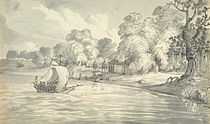Kara, Uttar Pradesh
| Kara | |
|---|---|
| town | |
 Kara Location in Uttar Pradesh, India | |
| Coordinates: 25°42′N 81°21′E / 25.700°N 81.350°ECoordinates: 25°42′N 81°21′E / 25.700°N 81.350°E | |
| Country |
|
| State | Uttar Pradesh |
| Languages | |
| • Official | Hindi |
| Time zone | IST (UTC+5:30) |
Kara is an old township situated near Sirathu, on the banks of Ganges, 69 km (43 mi) west of the city of Allahabad in Kaushambi district in Uttar Pradesh state in India. It was capital of a very big region for centuries under the Delhi Sultanate and Jaunpur Sultanate rule.
Name
It has been sometimes spelt at Karrah, Kada and Kurrah but actually it is Kara(in Hindi कड़ा and Urdu کڑہ )and often called with its sister town across the river Ganges called Manikpur. Still it is called Kara-Manikpur. Kara falls in Kaushambi district while Manikpur has now become a part of Partapgarh District.
Overview

Centuries ago it was the seat of the Governor of the Sirkar of Kara ("the Province of Kara"). Between the 7th century and the 16th century it retained its charm and importance as the capital, but in 1526, the Mughal emperor Akbar made Allahabad the capital and thus reduced Kara to a subdivision of the province. During British Rule, Allahabad gained so much importance that Kara went into oblivion and today it is a town of dilapidated havelis, forts, and monuments unknown. Hundreds of thousands of graves are lying in an area with a diameter of 7–8 km (5 miles). This stunning fact which emboldens its claim that it had been certainly inhabited by many people during its history.
In the 11th century the warrior saint of Islam, Saiyid Salar Masud Ghazi, defeated the princes of Manikpur and Kara, but Muhammadan rule was not established till the defeat of Jai Chand by Muhammad Ghorl. Manikpur and Kara on the opposite bank of the Ganges were important seats of government in the early Muhammadan period. Ala-ud-din Khilji was governor here, before he gained the throne of Delhi by murdering his uncle on the sands of the river between these two places. In the 15th century the district came under the rule of the Sharqi kings of Jaunpur, and after its restoration to Delhi the Rajput chiefs and the Muhammadan governors were frequently in revolt. The Afghans long retained their hold on the District, and early in the reign of Akbar the governor of Manikpur rebelled.
Kara lost its importance when Allahabad became the capital of a Province, and from that time it was merely the chief town of a sarkar. The Rajputs again rose during the anarchy which marked the disruption of the empire after the death of Aurangzeb. They were, however, gradually reduced by the Nawabs of Oudh, and in 1759 Kara was removed from the Sufrah of Allahabad and added to A lot of noble Muslim families had settled there. With the passage of time they left the town due to the lack of civic amenities and the carelessness of the government for the upkeep and development of the town.
It is the same place where Jalaluddin Feroz Khilji was murdered by his nephew Alauddin Khilji.
Shah Karak Abdal, a famous sufi saint lies buried here whose annual Urs is the largest Urs in the area of Allahabad.
Kara is a place of pilgrimage. It is the site of the holy temple of Kara Devi (Shitala Devi). Once the provincial capital of the Delhi Sultanate, its ruins extend 3.5 km (2.2 mi). This place has been a religious pilgrimage since at least A.D. 1000. Kara was also an important township in the medieval kingdoms of northern India and even today one can see the remains of the fort of Jaichand of Kannauj, the last Hindu king of Kannauj.
Places of historical interest include; the Dargah of Khwaja Karak, the Kara Devi Temple, the Samadhi of Saint Maluk Das, a mound called fort of Jai Chand, Jama Masjid, Kshetrapal Bharav Temple, Kaleshwar Mahadev Temple, and Shivala Maharishi Ashramractions.
Scores of noble families descended in Kara at various period of time. For examples Saiyid Qutub al Din Al Madani, Syed Riyaz Ahmad Naqshbandi, Saayid Abul Khair Mashhadi, Sayyed Muhammad Isfahani and scores of families of Shuyukh & Sadaat originated from here.Amongst them was a family of Sayyid Muhammad Isfahani who came and settled at Kara in 1256. The direct descendant of Syed Mohammad Isfehani lives in Allahabd. They also have their ancestor's house in Kara. There is one more family of Syed Riyaz Ahmad Naqshbandi who were lineal descendant of Hussein ibn Ali. In his life span he has settled in Fatehpur District, Uttar Pradesh now his son Syed Amin Ahmad alias Qasim Miyan lives in Syedwara, Fatehpur Uttar Pradesh.